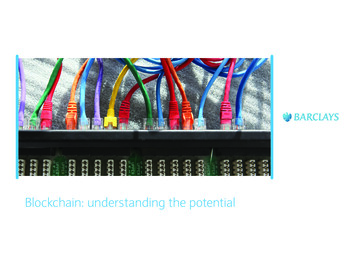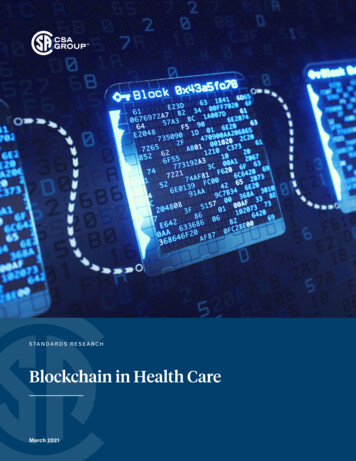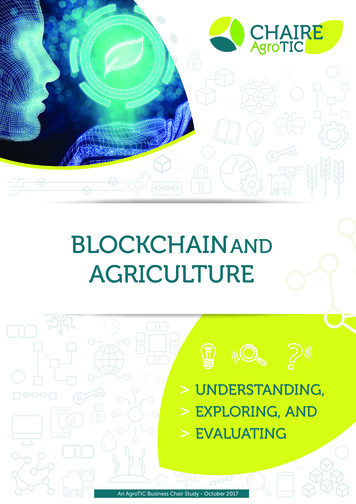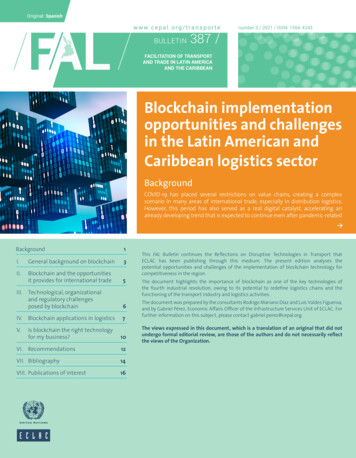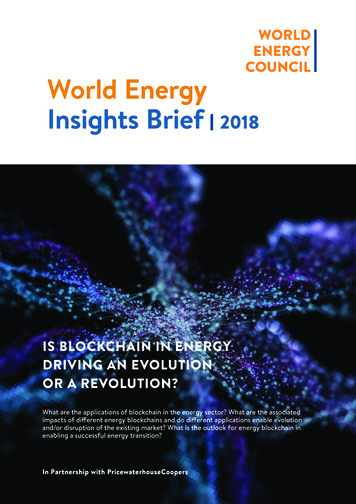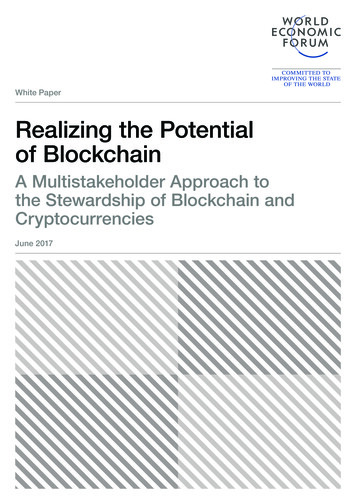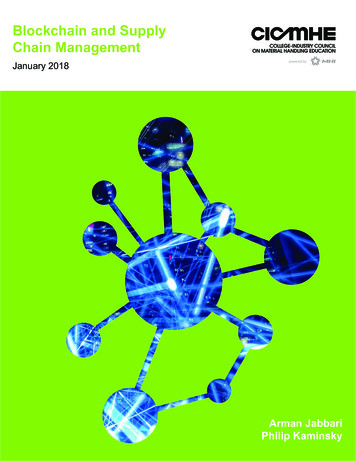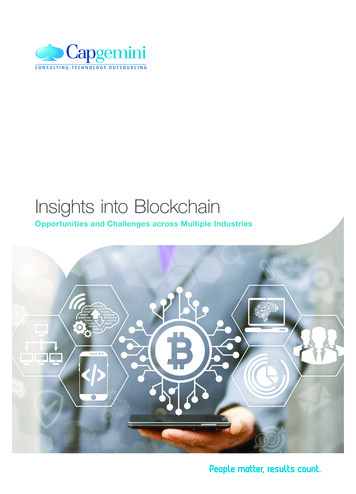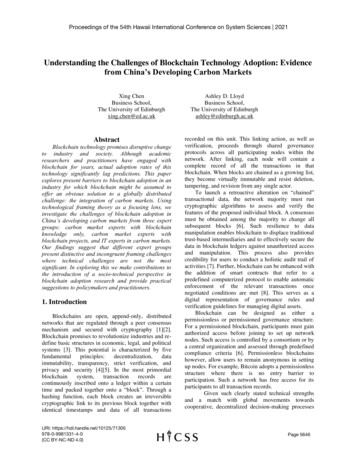
Transcription
Proceedings of the 54th Hawaii International Conference on System Sciences 2021Understanding the Challenges of Blockchain Technology Adoption: Evidencefrom China’s Developing Carbon MarketsXing ChenBusiness School,The University of Edinburghxing.chen@ed.ac.ukAbstractBlockchain technology promises disruptive changeto industry and society. Although academicresearchers and practitioners have engaged withblockchain for years, actual adoption rates of thistechnology significantly lag predictions. This paperexplores present barriers to blockchain adoption in anindustry for which blockchain might be assumed tooffer an obvious solution to a globally distributedchallenge: the integration of carbon markets. Usingtechnological framing theory as a focusing lens, weinvestigate the challenges of blockchain adoption inChina’s developing carbon markets from three expertgroups: carbon market experts with blockchainknowledge only, carbon market experts withblockchain projects, and IT experts in carbon markets.Our findings suggest that different expert groupspresent distinctive and incongruent framing challengeswhere technical challenges are not the mostsignificant. In exploring this we make contributions tothe introduction of a socio-technical perspective inblockchain adoption research and provide practicalsuggestions to policymakers and practitioners.1. IntroductionBlockchains are open, append-only, distributednetworks that are regulated through a peer consensusmechanism and secured with cryptography [1][2].Blockchain promises to revolutionize industries and redefine basic structures in economic, legal, and politicalsystems [3]. This potential is characterized by utability, transparency, strict verification, andprivacy and security [4][5]. In the most ntinuously inscribed onto a ledger within a certaintime and packed together onto a “block”. Through ahashing function, each block creates an irreversiblecryptographic link to its previous block together withidentical timestamps and data of all transactionsURI: 0(CC BY-NC-ND 4.0)Ashley D. LloydBusiness School,The University of Edinburghashley@edinburgh.ac.ukrecorded on this unit. This linking action, as well asverification, proceeds through shared governanceprotocols across all participating nodes within thenetwork. After linking, each node will contain acomplete record of all the transactions in thatblockchain. When blocks are chained as a growing list,they become virtually immutable and resist deletion,tampering, and revision from any single actor.To launch a retroactive alteration on “chained”transactional data, the network majority must runcryptographic algorithms to assess and verify thefeatures of the proposed individual block. A consensusmust be obtained among the majority to change allsubsequent blocks [6]. Such resilience to datamanipulation enables blockchain to displace traditionaltrust-based intermediaries and to effectively secure thedata in blockchain ledgers against unauthorized accessand manipulation. This process also providescredibility for users to conduct a holistic audit trail ofactivities [7]. Further, blockchain can be enhanced withthe addition of smart contracts that refer to apredefined computerized protocol to enable automaticenforcement of the relevant transactions oncenegotiated conditions are met [8]. This serves as adigital representation of governance rules andverification guidelines for managing digital assets.Blockchain can be designed as either apermissionless or permissioned governance structure.For a permissioned blockchain, participants must gainauthorized access before joining to set up networknodes. Such access is controlled by a consortium or bya central organization and assessed through predefinedcompliance criteria [6]. Permissionless blockchainshowever, allow users to remain anonymous in settingup nodes. For example, Bitcoin adopts a permissionlessstructure where there is no entry barrier toparticipation. Such a network has free access for itsparticipants to all transaction records.Given such clearly stated technical strengthsand a match with global movements towardscooperative, decentralized decision-making processesPage 5646
supported by more widely distributed sharedinfrastructure, it may appear surprising that adoption ofblockchain has lagged predictions [9][10]. To explorethis for a global cooperative movement where assetsneed to be registered and exchanged to better address acommon goal, we ask: what are the perceivedchallenges of blockchain adoption in carbon markets?proposals (white papers) highlighting potentials for thecarbon industry, whilst those published in academicjournals work split their focus on using blockchain toeither create a new carbon market or update existingschemes [25]. Drawing broadly on the above literature,blockchain is recognised to offer carbon marketsdistinctive strengths from the following two aspects.2. Blockchain and carbon markets2.1. Technical StrengthsA blockchain research community started toemerge in 2013 and has shown rapid growth since2016 [11][12]. Early research focused oncryptocurrencies such as Bitcoin and development oftheir protocols, design details of the peer-to-peertransaction network or characterization of theecosystem [13][14][15][16][17]. These discussions setthe tone of blockchain perceptions in relatedapplication areas and the direction of researchdevelopment with more than 80% of studiesemphasizing technical perspectives of blockchain andcryptocurrency systems and less than 20% dealing withblockchain adoption and implementation [16].Within these we focus on studies that investigatesocio-technical aspects and implications of blockchainadoption for the individual, organization, and society[5][17][18]. We find that adoption challenges frombusiness and societal perspectives have received littleattention [19] yet are critical when blockchain’scapacity for radical innovation is through concurrentintroduction of new management models andorganizational practices [5].In terms of an application focus, we also find thatdepth in blockchain application research has beennarrowly focussed on finance and the supply chain. Inthe arena of carbon markets there are influentialwhitepapers and working papers that have shaped thediscussion of blockchain application [20][21][22][23],yet the scholarly literature exploring blockchainapplication in this context remains superficial.Carbon markets mainly involve trading services,recorded as a certain amount of carbon credits andoffsets. Every single carbon credit or offset representsthe service of preventing one metric tonne of carbondioxide equivalent (CO2-e) from entering theatmosphere. However, the process of monitoring,reporting, and verifying (MRV) the carbon amounts iscomplicated and vulnerable to freeriding [24]. Whilemany organizations and experts have acknowledgedthe potential benefits and transformational nature ofblockchain technology for climate actions, no largescale deployment of blockchain solutions in carbonmarkets has been delivered. To date, there arenumerous organizational reports (such as UNFCCCand World Bank), research initiatives, and business2.1.1. Transparency, immutability and trust.Blockchain delivers a tamper-proof transaction ledgerthat boosts market confidence and avoids transactiondisavowal [4]. This ledger comes with transparencythat increases the accountability of carbon mitigationefforts and maintains information credibility [26].A blockchain ledger for carbon trading cansynthesize and support the transaction of all kinds ofmitigation-related data (e.g., facility level, projects,quantified production, and life cycle attributes) in ashared, globally accessible environment [22]. Thisledger system can avoid carbon leakage by allowingparticipants to trace and audit the end-to-end process.Blockchain raises the cost of conducting fraud of data,and tax evasion scams and boosts trust and confidencein the carbon market mechanism.The behavioural impacts of this could be profound.With all information under scrutiny, marketparticipants are forced to behave in a responsible andaccountable manner in collecting and recording data.Monitoring and verifying the source and ownership ofcarbon credits helps protect the trading from fraud andother problems such as double accounting [27][28].The enhanced transparency also increases thecarbon market’s efficiency by tackling asymmetricinformation at the transaction level. The currentsecondary market suffers from low liquidity andunstable prices [29]. Poor information sharing oncarbon credit unit holdings and trading has distortedinvestment and price signals, such that one can knowlittle about the reputation of its counterparties and thequality of their carbon unit credits [25]. Once theprocess of carbon credits issuance is trackable andinformation is more credible, potential purchasers willhave more confidence in the credit’s quality andparticipate in the carbon markets more actively.2.1.2. Peer-to-peer efficiency and effectiveness.Blockchain-empowered carbon markets can increasethe efficiency and effectiveness because it speeds updata transfer in peer to peer (P2P) networks [18][30]and widens the geographical scope of feasible trading.Such an infrastructure can be regarded as distributeddatabase system that allows multiple participants tomake alterations in the system at the same time. ThisPage 5647
encourages individual participation in voluntarymarkets where they can save carbon emissions on adaily basis and exchange it freely with others. Moreimportantly, blockchains enable the automatedexecution of smart contracts in P2P networks [31]. Theautomated trading platform will present price signalsand information on carbon costs to consumers in anefficient way, simultaneously incentivizing them fordemand response and smart management of theircarbon allowance needs [32].Blockchains can also increase the efficiency of thecarbon markets by lowering transaction costs. Thetraditional MRV process includes complex work done‘in the field’ by many people and multiple layers ofdata checking and reporting, representing large humanresource and time investments that may havesignificant opportunity costs. Smart contracts allowmore automation of the MRV process, reducing theinvestment hurdle for project proponents and thebureaucratic overhead. Smart contracts can also beused to help generate the carbon credit unitsautomatically, making the issuance process muchsimpler and reducing the barrier to entry of smallermitigation projects. Currently, it takes a regulatorseveral weeks to evaluate a report for carbon credit unitcreation, hence blockchains offer the promise of fasterregulation through real-time evaluation.Since existing carbon markets around the world arefragmented and heterogenous, networking shouldfoster market liquidity, reduce compliance costs,promote environmental technology transfer king has been held back by multiple challenges:harmonization of MRV provisions [33][35], doubleaccounting [27][36], loss of regulatory autonomy[37][38]. The emergence of blockchain provides abottom-up solution to networking carbon marketswithout forcing legal and regulatory homogeneousstandardization and conformance on those markets[39][23]. Jackson et al. [23] proposed a federalblockchain system to not only run different carbonmarkets with required function designs but alsointeroperate and allow data transfer between thedifferent levels. Blockchains therefore promise supportfor networking global emission trading systems as wellas an adoption approach that enables widerparticipation and engagement, enhancing the long-termeffectiveness of the ETS mechanism.2.2. Technical ChallengesWhile blockchain is believed to help transit fromthe centralized and linear models of carbon generationand consumption models towards decentralized,distributed and inclusive carbon trading systems, itfaces challenges that need to be addressed if it is todeliver the desired environmental and social impacts.Currently, most focus has been on the recognition andresolution of technical obstacles [16][6].2.2.1. Excessive Energy Consumption. One of themost frequently discussed challenges for blockchainapplications is energy requirement. The extent of suchis a design choice determined by the openness of thenetwork (permissioned or permissionless) and the typeof consensus mechanism. A permissionless blockchainnetwork with a “Proof-of-Work” (PoW) consensus,like the Bitcoin system, would require highcomputational power and attendant consumption ofenergy. The permissioned private blockchain system,in contrast, needs less energy because only a few nodesare entitled to put the next block of transactionalrecords into the joint network data history.This does, however, impact security and scalability.The PoW mechanism enables all network nodes tocompete to solve the mathematical formula and win theright to record. This solving process needs substantialpower for repetitive trials and error exercises, makingit unlikely for hackers to predict the winner and henceimpossible to attack directly. One energy-efficientsubstitute to PoW is “Proof of Stake” (PoS) whichderives from the Ethereum Blockchain and includes avoting system for choosing the validators fromqualified nodes with coins staked. This type ofconsensus algorithm only needs a small amount ofenergy because the network participants do not have tosearch and seek appropriate hashes. Malicious attack tothis algorithm requires hackers to purchase a large sumof tokens and hence quickly becomes uneconomic. Forexample, the Confidential Consortium (CoCo)Blockchain Framework from Microsoft is apermissioned private network that replaces the PoWmechanism with simplified consensus and reducedduplicative validation, greatly lowering the electricityconsumption [40].2.2.2. Limited Scalability. Scalability emphasizes thenumber of users blockchain could accommodate in atime interval and the speed with which it can validatethe blocks. Permissionless blockchains normallystruggle to scale up performance because of aninefficient consensus mechanism. Bitcoin, for example,has a 1MB block size and each block can hold around2,000 transactions. Restricted by the validatingprocess, it takes an average of 10 minutes to produce ablock, leading to seven transactions per second. Incontrast, the Visa credit card system has over 65,000transactions processed within the same period.As noted in relation to energy consumption above,the challenge of scalability can be mitigated within aPage 5648
permissioned blockchain system by replacing the PoWmechanism with a more effective consensus choice,realizing higher transaction volume at lower menon in a particular context [45][46][47][48] in this case blockchain in China’s carbon markets.2.2.3. Rubbish in, Rubbish out. Although theblockchain system can keep data immutable, it is oftenmisunderstood that data on the “chain” are accurateand represent the ‘truth’. In fact, blockchain cannotintrinsically guarantee data accuracy nor prevent anyform of fraud or crime before data is moved onto the“chain”. When wrong data are inscribed in a block andfinally transferred to the network with other blocks, thesystem does not verify, but preserves originality andreplicates to other nodes for storage. This drawback isdescribed as “Rubbish in, Rubbish out”.To improve data quality in the blockchain network,the accountability of the data provider and the processof data transfer, from generation to recording, shouldbe ensured. While the former is more feasible in apermissioned network where participants’ actions canbe designed to be transparent, the latter can be realizedin conjunction with other technologies such as GPS,RFID, or other IoT devices, for automatic data transfer.3. Research methodology2.3. Framing ChallengesResearch on IT innovation adoption and diffusionhas accumulated a quite rich body of theoretical andempirical work. In this tradition, researchers tend toput more focus on the implementation phase, with lesson the pre-adoption phase [7]. However, the preadoption phase plays an important role fororganizations to explore a technology’s features,investigate its benefits and challenges in theapplication domain, and determine whether or howmuch they will invest in it, especially when thetechnology is complex and potentially disruptive.Previous research on adoption has employedbehavioural models, such as TRA [41], TAM [42],TPB [43], and UTAUT [44], to reveal factors thatinfluence organizational adoption of a particulartechnology. Such research frames technology adoptionas deterministic, yet provides limited insights into howpotential adopters recognise a new technology aspotentially relevant and then form assumptions,expectations, and knowledge of this innovation thatshape their later actions.In this paper, technology is framed as socialartifacts with their materials and functions embodyingstakeholders’ knowledge, objectives, values, andinterests in that technology [45]. We take a socialcognitive approach to research the pre-adoption phaseand use the theoretical lens of technological framing toidentify the sets of members’ group frames pertainingto the assumptions, expectations, and knowledgeOur sample focuses on experts from China’s carbonmarkets who have an understanding of blockchaintechnologies and are capable of contextualizing itsadoption. These include senior executives or managerswho had profound domain knowledge of China’scarbon markets operation and had an in-depthunderstanding of IT; those who are IT experts with asufficient understanding of China’s carbon marketsoperation; or those who are expert in both domains.The procedure for interview preparation had threesteps: first, we started with the collection of onlineresources (conference reports, blogs, projectwhitepapers) that discuss blockchain application inChina’s carbon markets and extracted a list of potentialcandidates for interview (retaining these sources forlater triangulation of responses). We also consideredthat there might be experts in China’s carbon marketswho are not visible in public, yet have a deepunderstanding of our research topic. Therefore, weidentified key senior officers at the Ministry ofEcology and Environment of the People’s Republic ofChina responsible for ensuring attainment of nationalemission reduction targets and involved in governingChina’s carbon markets [49]; the Certification andAccreditation Administration of the People’s Republicof China (CNCA) responsible for research andstandardisation related to accreditation and conformityassessment (involving information system deploymentstandards in national carbon markets) [50]; theAlliance of Carbon Emissions Trading; the ChinaEnergy Conservation Association; and senior carbontrading managers in some enterprises such as ChinaNational Offshore Oil Corporation (CNOOC).Holding these two name-lists, we used a personalresearch network established through two decades ofcollaborative international work involving the ChineseAcademy of Science to approach experts directly, orindirectly through key industry conferences or events.Those experts meeting the selection criteria were sentan interview protocol and an interview arranged.These two steps only identified seven carbonmarket experts that met the criteria. Guided bypurposive sampling and data saturation [51][52], weutilized the snowballing technique [53] to ask whomelse the interviewee recommended as relevant to thestudy. Our sampling process ceased when no newinformants were being recommended, leading to a totalof 15 carbon market experts (Table 1).Page 5649
Table 1. Interviewee characteristicsRole ndercompany providing blockchain solutions to carbonmarketscarbon consulting service providercarbon consulting service providercarbon consulting service providercarbon consulting service providercompany providing blockchain solutions to carbonmarketscompany providing blockchain solutions to carbonmarketscompany providing blockchain solutions to carbonmarketscompany providing blockchain solutions to carbonmarketsLow carbon test and certification centerGreen Finance Association, Municipal Bureau ofFinancial workLow Carbon Research Instituteinformation system service provider in carbon marketsinformation system service provider in carbon marketsinformation system service provider in carbon 1PT051PT06Face to faceFace to facePhonePhonePhoneEBP1PT07Face to FaceEBP1PT07Face to FaceEBP1PT08PhoneEBKEBK2NP012NP02Face to FaceFace to faceEBKIT expertsIT expertsIT experts2NP033IT013IT023IT03PhoneFace to FaceFace to FaceFace to FaceChairman & CEOCo-Founder & CEOCo-FounderCEOCo-Founder & CEOCo-Founder & CEOStrategy DirectorCo-Founder & CEODeputy DirectorSecretary GeneralOperation DirectorIT leaderIT ManagerCEONote: EBP (experts, with blockchain projects) are those with experience of innovative carbonmitigation projects that integrate blockchain technologies. EBK (experts, only with blockchainknowledge) are those reporting a strong understanding of blockchain but no project experience.3.1. Data analysisAll interviews were recorded with explicitpermission and then transcribed. The transcriptionswere supplemented by, and triangulated with, thesecondary data described earlier, enabling ambiguousexpressions to be clarified and amplified.Following the procedures suggested by Corbin andStrauss [54], our analysis unfolded in two main phases.In the first phase, we began an “open coding” approachto identify concrete challenges as framed by differentgroups of experts. Interview transcripts were examinedthrough a form of content analysis and expert quoteswere categorized into first-order codes after thegrouping of similar keywords and central meaningsrelated to challenges. After several rounds of reexamination, we settled on a set of first-order codesthat covered as much of the data as possible,representing different ways in which experts perceivethe challenges of blockchain application.In the second phase of coding, we re-grouped thefirst-order codes into more abstract second-order codesthat summarised the concrete challenges into broadercategories of challenges. We conducted an iterativeexamination with an objective to cover the majority ofstatements in the first-order codes. Eventually, sevenframe content domains were generated, and theoreticalsaturation was achieved [55]. These domains werefurther compared and analyzed for similarities anddifferences across functions and experiences.4. FindingsAfter conducting a deep analysis of thetechnological frames of three groups of experts, weadapted some of the frames proposed in Sun andMedaglia’s work [56] and finally resolved seven typesof perceived challenges of blockchain application inChina’s carbon markets: social; political, legal andpolicy-related; data; organizational and managerial;economic; context and technological.Table 2 below offers a summary of perceivedchallenges in the adoption of blockchain technologyfor each group across the seven dimensions. Weexplore key themes that emerge from the research inrelation to carbon markets in the following section.4.1. Social challengesThe social challenges to the wide adoption ofblockchain in carbon markets were recognized by allthree groups of experts. The first perspectivefrequently mentioned is a paucity of understanding ofblockchain’s potentials in China’s carbon market[2NP02, 3IT01]. This finding is consistent with ourPage 5650
interviewee selection experience that experts knowingboth areas remain rare.The second perspective is that the insufficientunderstanding causes people to distrust blockchain.Their cognition is generally influenced by associatingblockchain with cryptocurrencies, imposing a negativeconnotation such as illicit transactions in the deep weband Ponzi schemes related to initial coin offerings(ICO) [1PT08, 2NP03].The third perspective focuses on difficulty intransforming from established centralization to thedecentralization associated with blockchain [1PT06].Table 2. Experts’ framing of challenges in blockchain adoption in carbon marketsCATEGORIES OF CHALLENGESKeyplayersSocialPolitical,legal &policyDataEBP- nput dataunderstanding securityquality notfrom scamsthreats/data guaranteedleakageTraditionalNo legal orthinking/model regulationofdocumentscentralizationLack ofsupportivepolicyenvironmentEBKWillingness to Lose control Data- Expertsunderstand Is of adjusting securityonly withnot strongrelated put dataunderstandingquality notfrom scamsguaranteedIT experts Difficult toLack ofUncertaintyunderstandsupportiveof datathe technology policyownershipenvironmentConcernsInput dataabout future quality notlegalguaranteedpenalties4.2. Political,challengeslegal,andOrganizational Economic Context& managerialTechnologicalLack of a largescale ofcoordinationInsufficientmarketpreparationLimited datastorage on theblockchainNot wellevolved andnoreplacementLowtransactionspeedHigh costinblockchainadoptionLack ofUncertaintyinterdisciplinary of profitstalents affectinggovernment’scognitionNo officialleadershipInsufficientmotivation forintegrationUncertaintyof profitsLack ofinterdisciplinarytalentsLack ofHigh costinterdisciplinary intalentsblockchainadoptionNo officialleadershippolicy-relatedAll three expert groups mentioned these challenges,and, in particular for EBP, eight of nine experts hadextensive discussions on these three perspectives.The feature of decentralization was seen as apolitical threat. In China, the carbon marketmechanism is regarded as a policy instrument to reduceemission of greenhouse gas and thus the marketrequires a high level of involvement with governmentalregulation and control. Adopting blockchain in themarket raises central government concerns aboutdisempowerment and dilution of its functions marketadministrationin provincesNot wellevolved andnoreplacementregulating and controlling carbon emissions,particularly when the smart contract enablesautomation in carbon market management. One experthighlighted this challenge: “theoretically, blockchaincan be adopted to realize the fair allocation of [carbonemission] permits, by putting issuing rules into thesmart contract and automatically issuing [carbonpermit] tokens. However, it is almost impossible for thegovernment to do this because the automation wouldmake the government lose control of adjusting theallowance in detail. This is like issuing fiat money outof control of the central bank” [2NP01]. In addition,the immutability and transparency of data records onblockchain generate another threat to national securityPage 5651
for the government. Once these data are leaked, theindustrial distribution will be exposed, which threatensnational economic security. As one expert emphasized:“To the government, the adoption of blockchain in thecarbon market may violate their own interests makingChina’s national energy consumption data exposed tothe globe for 100%. Even though there is a federalblockchain with permissioned access and transparencyto all its user participants, it is highly likely that thereare some spy companies exposing all energyconsumption data to other countries. If one countryknows our energy consumption data, they can inferwhat our national industrial chain is like, damagingnational economic security” [1PT07].Despite these political aspects, the regulation ofblockchain adoption is largely nascent in carbonmarkets. There have been no official legal documentsor regulation details that can guide the early practice,making it risky for the industry to embrace suchtechnology rapidly [1PT04]. While current regulationsof blockchain in the general finance industry andmedia opinion are strict, organizations in the carbonmarket are concerned about whether their efforts inearly time will be in vain or, even worse, whether theywill get punished as a result of some actions [1PT02].To incentivize organizations to transfer their attentionto blockchain, a positive policy environment isrequired to attract more practitioners. Without thegovernment’s promotion and support in eithercoordination or finance, organizations will have atough time making progress in pushing the adoption toa wider range [1PT03] – in China the development ofindustry is always driven by government [3IT01].4.3. Data challengesData challenges associated with blockchainadoption in carbon markets are framed as highlyrelevant by EBK and IT experts, but not by EBP.These data challenges include data quality, datasecurity, and data ownership.The first data challenge is related to data qualitywhich consists of two levels. First, although blockchainis advantageous for immutability and traceability ofdata recorded on the chain, this does not mean theoriginal data itself is authentic and accurate: “theallocation of carbon emission permits concerns reportdata from each company. However, if these originaldata were falsified before reporting to the government,then authenticity and accuracy would not be solvedeven when blockchain develops to version 10.0”[1PT01].Second, the data collection method can alsoinfluence data quality. Traditional manual collection ofMRV data can bring in intentional or unintentionalerrors, and hence blockchain still needs collaborationwith some other mature technologies to maintain highdata quality: “Blockchain only solves out the digitaltrust problem. To transform the business world to bedigitalization, how to map the physical world with thedigital world is key. We need advanced technologieslike IoT to maintai
Understanding the Challenges of Blockchain Technology Adoption: Evidence from China’s Developing Carbon Markets Xing Chen Business School, The University of Edinburgh xing.chen@ed.ac.uk Ashley D. Lloyd Business S
